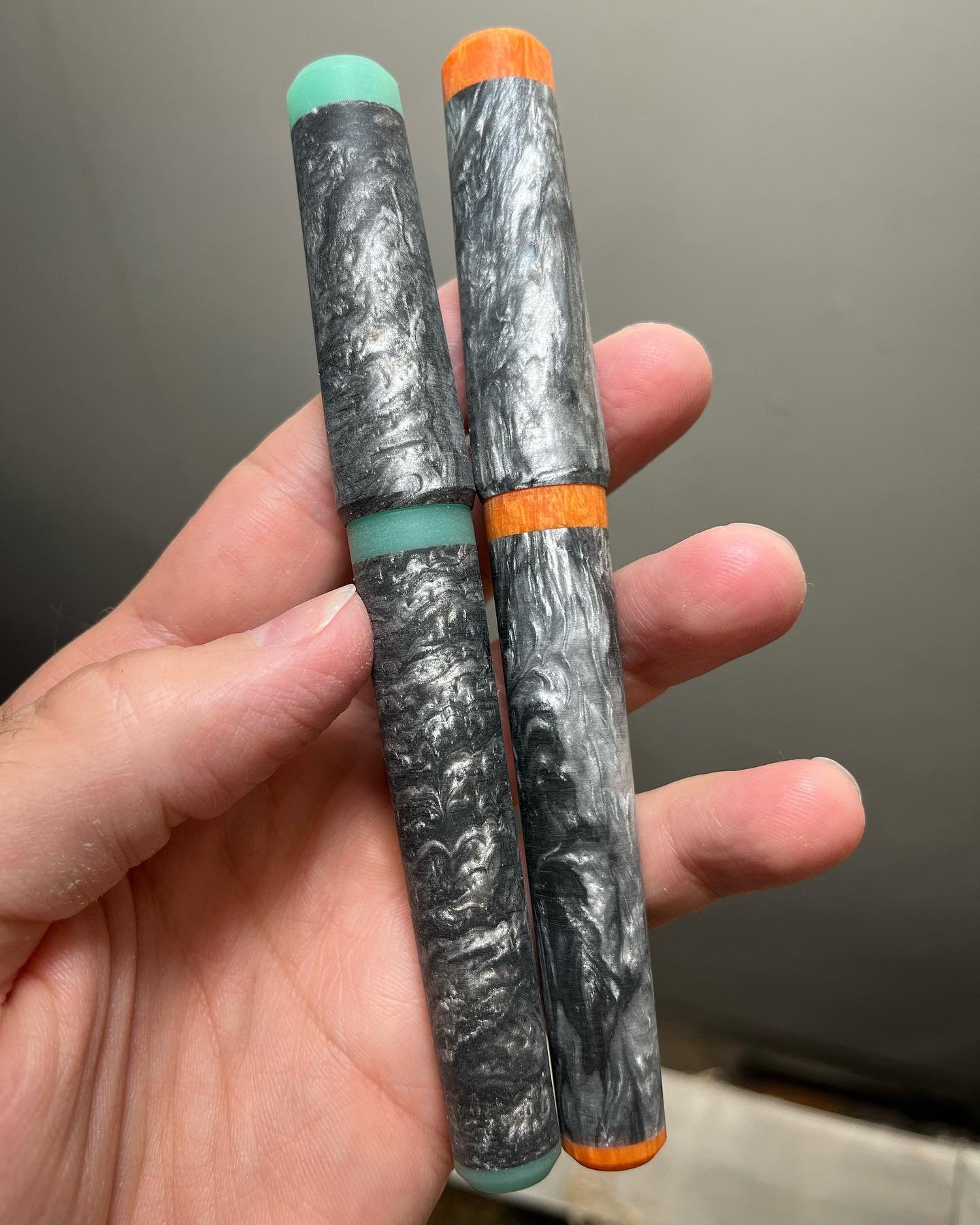(Caroline Foty's first fountain pen was a 1970s Sheaffer No Nonsense that still writes perfectly. Since she discovered pens by independent makers, she wants "one of each, please" and wants to meet all the makers. Maybe you do, too. She lives in Baltimore with pens, cats, and all kinds of fiber arts supplies.)
Jason Miller made his first pen as a teenager with equipment set up on the tailgate of a truck. His grandfather, an industrial technology teacher, learned to make kit pens and decided to bring all his equipment at Christmas and teach his grandchildren. They loved it so much that he went out and bought them all the required stuff as Christmas presents, and they started making kit pens in the living room.
The brothers played around with pens off and on for years and then moved on. However, after graduating from architecture school and taking a high pressure job, Miller remembered the tools and retrieved them from his parents’ garage, looking for something therapeutic to relieve stress. When he started sharing pictures of his pens on Instagram, people wanted to buy them. “I thought, ‘Oh, that’s a thing??’” When he set up as a business in 2016, he honored his grandfather, Neil Tucker, in his company name as well as the name of his flagship model, the Tucker.
Fountain pens came into his repertoire after about a year, when he began seeking out better kits, and that was when his business really took off; his first customer was located in Hong Kong. He began to find kit pens limiting – “There is a framework you have to work within, in terms of shape and size, so mixing it up with the wood is all you can do.” To add variety to his kit pens he did some wood inlay and layering. Then he came across a set of YouTube videos by Bob Blandford, who had started dabbling in kitless pens and produced a video outlining all the tools they require. Already having the major equipment, adding the tools for kitless pens was not a crazy investment, although his wife was skeptical – “Why is he doing this??” But once he got started, “there was no going back. I gave all my kit pen tools to a friend.”
Miller first tried to diversify his pens by buying a wider selection of blanks at the wood store. He quickly found that he hated working with acrylic, which can be brittle. Then he spotted some square resin blanks at Exotic Blanks and that was more to his liking, so he began following the work of more makers and took note of where they got their materials.
Instagram also led to another of Miller’s endeavors, the As The Pen Turns podcast, when he hit it off with Brad Owens of Mythic Pens. After sharing their work and the work of other makers, they did a joint livestream giveaway, and due to Brad’s radio-friendly voice they received several comments that they ought to do a podcast. After thinking about it for awhile, they jumped in. “We figured we’d maybe have enough to talk about for like ten episodes, but we’re almost fifty episodes in, and by now everyone should know we have ZERO issues talking for extended periods!”
For a number of years, Miller swore he would never make his own blanks. “I hate picking colors at work for clients’ buildings, but it turns out I love doing it with materials.” When Jonathon Brooks joined the podcast as a cohost, he felt able to ask him lots of questions, and his interest grew until he took the plunge. His inspiration for his blanks comes from nature – one particularly striking recipe was based on a colorful photograph of a luna moth. “I don’t like to be arbitrary in my colors, but to be inspired by things in nature.”
Miller is continuing to seek new horizons in his work. “I’m confident with kitless pens, what’s next? When I get the bug to experiment, what can I create?” He considered metal work – clips, finials, bands – but the cost of entry to that craft was relatively high. So he decided to narrow his focus to the Tucker model (as well as the Tucker 48, an eyedroppered variation on the theme), letting his five or six other models go to work on making the Tucker the best crafted pen it can be. “Many people say they follow the lead of the material when they make pens, my focus is on the technical accuracy.” Visiting pen shows for the first time, he felt pressed to find ways to make his work unique. This pressure has led him in a couple of new directions.
“I picked out the pens I’ve made that I really liked, and noticed that many of them are using multiple segments of colors.” Having both his own blanks and a bin of blanks he’s gotten from other makers lets him mix and match and see what colors he has that go together well. He also has a new blank recipe, called Damascus, that simulates the color and texture of forged steel, and is using that as a background for pops and spots of solid color, as well as experimenting with subtle variations in the recipe to achieve different effects.
Miller enjoys being challenged by the work of other makers in the community who are pushing the limits of pens in one direction or another. “I want to keep it interesting for myself. I’m trying to get back to the origin of this – it’s a side business, but I want to get back to the creativity and the fun of doing it.”
Part of the fun is pushing his own skills. “I’m an architect – how complicated can I make it?? Making intricate things that meet my standards for aesthetic quality, following something like that to completion, inspires me.”
What’s a favorite pen that you didn’t make yourself? There are a few. “My favorite is a Pilot Custom 823 with a custom architect grind by John Mottishaw. I use it at work all the time. Also I have five Pilot Metropolitans inked with different colors that I take to work every day to color code my work notes.”
Like many other makers, Miller draws satisfaction from the place of what he does in a larger context. “You start with nothing, put ingredients into a pot, take them out, and from that inanimate object create art that someone else can use to create art. It contributes to the community that keeps handwriting alive. It has an infinite life.”
Jason Miller’s work can be seen on Instagram, his website Jason Neil Penworks, and maybe a pen show or two in the future.
Enjoy reading The Pen Addict? Then consider becoming a member to receive additional weekly content, giveaways, and discounts in The Pen Addict shop. Plus, you support me and the site directly, for which I am very grateful.
Membership starts at just $5/month, with a discounted annual option available. To find out more about membership click here and join us!













